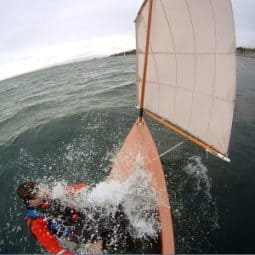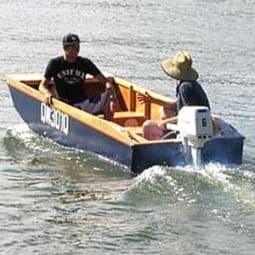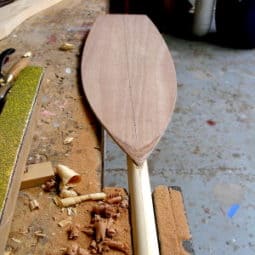There are a number of labour and materials saving techniques that reduce labour and reduce the quantity and cost of epoxy used
Contents of this section
- Wet-on-Wet Coating and Dewaxing Cured Epoxy.
- Building strong lightweight boats – a note on the use of epoxy
- One Hit coating and gluing
Wet-on-Wet Coating and Dewaxing Cured Epoxy.
As epoxy cures some of the unreacted components migrate to the surface, leaving a waxy residue.
This can reduce the adhesion of following coats, whether epoxy or paint and make them go “fish-eyed” (the surface finishes pitted).
![]()
Some epoxies have a good reputation for not waxing (or waxing rarely)
The wet-on-wet application method is still the best so you don’t have to sand between the epoxy coats.
Some epoxies are sold as non waxing. During the building you will get to know your epoxy intimately. I think this explains a lot about brand loyalty … we get to know the ones we use a lot.
But all can wax under some conditions.
This is why I always use a “wet-on-wet” epoxy application method (see “epoxy coating” above). If the surface is allowed to cure it will have to be dewaxed as insurance if in a commercial situation.
![]()
If sandpaper clogs or the surface feels slippery or sticky. It could be wax.
If you get fish eying … small dents in the epoxy where the fresh epoxy draws back from spots of contamination … then it was likely to be wax.
Dewaxing – When the two to three coats have cured I always de-wax the surface using a plastic domestic scourer (Scotchbrite) and water maybe with a small amount cloudy ammonia added, though WEST (the most technically correct information source) has changed their advice to say water is enough. Scrub very thoroughly.
You can then sand the surface to key it for further painting, epoxying or gluing.
Building strong lightweight boats – a note on the use of epoxy
Epoxy is expensive stuff, so when there is a bit left over from a process there is a temptation to use it somewhere.
Don’t do it! The boat has been carefully designed to be strong enough already – all you will do is add weight and ruin the boat. Where you can use it for a legitimate step, do so – but think about it first.
![]()
Another time it is best to throw out epoxy is if it is starting to go off in the bag or tin. If it is starting to get too hot to comfortably hold it is going to be hard very shortly – you are unlikely to have enough time to put it into place.
Furthermore, hot epoxy fillets slump badly, hot coatings wax and get fish-eye pitting, and hot glue joins end up with lumps that stop clamping. Make up a smaller mix next time and get it out on the surface earlier – straight after careful mixing in the tin or bag.
One Hit coating and gluing
An extension of wet on wet epoxying is a method for coating areas that are easy to get at now (plain plywood compenents) may be hard to get at a bit later when other parts are attached. A couple of examples are fitting the bottom, fitting the side decks and fitting framing to the bulkheads.
For example if gluing the bottom panel in place it is easy to coat the inside of the bottom at the same time. For major gluing processes like this it is important to make sure that everything will work smoothly – do a DRY RUN without the epoxy to make sure that you have enough screws etc to hold the bottom on OK – you can use the same holes again when you are putting the bottom on permanently.
This is the method (put on your disposable gloves!!!).
1/ get all the framing that the bottom will be attached to bevelled and ready to accept glue
2/ put three coats of epoxy “wet on wet” on the inside of the bottom as per the mehod in the appendix above.
3/ immediately put glue (epoxy plus the gluing thickening powder – make up to a peanut paste thickness) on all the framing of the hull that the inside of the bottom will be glued to – spread it out ready to take the bottom.
4/ drop the bottom on with its wet face in contact with the glue in the previous step and screw the bottom in place.
5/ clean up any excess glue that has squeezed out of the joints about 20 minutes after the assembly. If you wait till tomorrow you will be sanding forever. Use a flat piece of timber sharpened to a chisel edge on the end with a sander.
The same method can be used when putting the framing on the bulkheads. Coat one side of the bulkhead immediately before gluing the framing on that side.



















